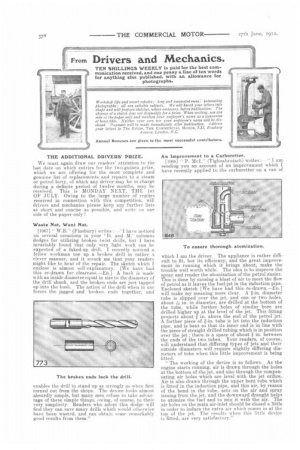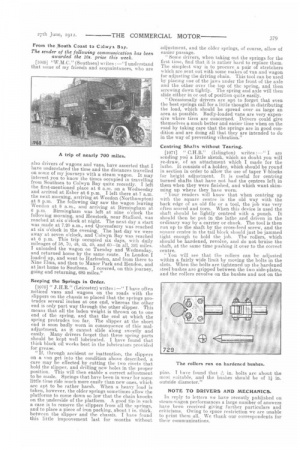From Drivers and Mechanics.
Page 28

Page 29

If you've noticed an error in this article please click here to report it so we can fix it.
TEN SHILLINGS WEEKLY is paid for the best communication received, and one penny a line of ten words for anything else published, with an allowance for photographs.
Workshop tips and smart rePairs; long and successful runs I interesting photographs ; all are suitable subjects. We will knock your letters into shape and will prepare sketches. where necessary, before Publication. The absence of a sketch does not disqualify for a prise. When wgiting, use one side of the paper only and mention your employer's name as a guarantee of bona fides. Neither your own nor your employer's name will be disclosed. Payment will be made immediately after publication. A ddress YOU? letters to The Editor, THE COMMERCIAL MOTOR, 7-15, Rosebery
Avenue, London, E.C.
Annual Bonuses are given to the most successful contributors.
THE ADDITIONAL DRIVERS PRIZE.
We must again draw our readers' attention to the last date on which entries for the two-guinea prize, which we are offering for the most complete and genuine list of replacements and repairs to a steam or petrol lorry, of which any driver may be, in charge during a definite period of twelve months, may be received. This is MONDAY NEXT, THE 1sT OF JULY. Owing to the large number of replies received in connection with this competition, will drivers and mechanics please keep any further lists as short and concise as possible, and write on one side of the paper only?
Waste Not, Want Not.
[1067] W.B." (Finsbury) writes:--"I have noticed on several occasions in your 'D and M.' columns dodges for utilizing broken twist drills, but I have invariably found that only very light work can be expected of a faked-up drill. I recently noticed a fellow workman use up a broken drill in rather a clever manner, and it struck me that your readers might like to hear of the repair. The sketch which I enclose is almost self-explanatory. [We have had this re-drawn for clearness.—En.] A bush is made with an inside diameter equal in size to the diameter of the drill shank, and the broken ends are just tapped up into the bush. The action of the drill when in use forces the jagged and broken ends together, and enables the drill to stand up as strongly as when first turned out from the shops. The device looks almost absurdly simple, but many men refuse to take advantage of these simple things, owing, of course, to their very simplicity. Readers who adopt this dodge will find they can save many drills which would otherwise have been wasted, and can obtain some remarkably good results from them." An Improvement to a Carburetter.
[1068] P. Mel." (Tighnahruiach) writes : I am sending you an account of an improvement which I have recently applied to the carburetter on a van of
which I am the driver. The appliance is rather difficult to fit, but its efficiency, and the great improvement in running which it brings about, make the trouble well worth while. The idea is to improve the spray and render the atomization of the petrol easier. 'This is done by causing a blast of air to meet the flow of petrol as it leaves the fuel-jet in the induction pipe. Enclosed sketch [We have had this re-drawn.—En.} will make my meaning more clear. A i-in. diameter tube is slipped over the jet, and one or two holes, about -N in. in diameter, are drilled at the bottom of the tube, while further holes of similar bore are drilled higher up at the level of the jet. This fitting projects about.1 in. above the end of the petrol jet. A further piece of -I-in. tube is let into the induction pipe, and is bent so that its inner end is in line with the piece of straight drilled tubing which is in position over the jet ; there is a space of about I in. between the ends of the two tubes. Your readers, of course, will understand that differing types of jets and their outside diameters will require slightly differing diameters of tube when this little improvement is being fitted.
"The working of the device is as follows. As the engine starts running, air is drawn through the holes at the bottom of the jet, and also through the compensating air holes which are level with the jet orifice. Air is also drawn through the upper bent tube which is fitted in the induction pipe, and this air, by reason of the bend in the tube, acts on the air and spray issuing from the jet, and the downward draught helps to atomize the fuel and to mix it with the air. The air holes on the main air-inlet should be closed a little in order to induce the extra air which comes in at the top of the jet. The results when this little device is fitted, are very satisfactory."
From the _South Coast to Colwya
The sender of the following communication has been awarded the 10s. prize this week.
[1060] "W.M.C." (Southsea) writes : —"I understand that some of my friends and acquaintances, who are
also drivers of wagons and vans, have asserted that I have understated the time and the distances travelled
on some of my journeys with a steam wagon. It may interest you to know the times occupied in travelling from Southsea to Colwyn Bay quite recently. I left
the first-mentioned place at 6 a.m, on a Wednesday and arrived at Esher at 6 P.m. I left there at 7 a.m. the next morning, arriving at Weedon (Northampton) at 8 p.m. The following day saw the wagon leaving Weedon at 8 a.m., and arriving at Birmingham at 6 p.m. Birmingham was left at nine o'clock the following morning, and Henstock, near Stafford, was reached at six o'clock at night. The next day a start was made at 7.20 a.m., and Queensferry was reached at six o'clock in the evening. The last day we were away at seven o'clock, and Colwyn Bay was reached at 6 p.m. This trip occupied six days, with daily mileages of 58, 70, 48, 45, 40, and 60—in all, 321 miles. I unloaded the wagon on Tuesday and Wednesday, and returned home by the same route. In London I loaded up, and went to Harlesden, and from there to Nine Elms, and then to Manor Park and Hendon, and at last home to Southsea. I covered, on this journey, going and returning, 685 miles."
Keeping the Springs in Order.
[1070] " J.H.R." (Leicester) writes :—" I have often noticed vans and wagons on the roads with the slippers on the chassis so placed that the springs protrudes several inches at one end, whereas the other end is only part way through the other slipper. This means that all the laden weight is thrown on to one end of the spring, and that the end at which the spring protrudes too far. The slipper at the short end is soon badly worn in consequence of this maladjustment, as it cannot slide along sweetly and easily. Many drivers forget that these spring parts should be kept well lubricated. I have found that thick black oil works best in the lubricators provided for grease.
"If, through accident or inattention, the slippers on a van get into the condition above described, a cure may be effected by cutting the two rivets that hold the slipper, and drilling new holes in the proper position. This will then enable a correct adjustment to be made. Springs that have been in wear for some little time ride much more easily than new ones, which are ant to be rather harsh. When a heavy load is taken, however, the older springs sometimes allow the platforms to come down so low that the chain knocks on the underside of the platform. A good tin in such a case is to remove the slippers from all the springs, and to place a piece of iron packing, about 1 in. thick. between the slipper and the chassis. I have found this little improvement last for months without
adjustment, and the older springs, of course, allow of easier passage. " Some drivers, when taking out the springs for the first time, find that it is rather hard to replace them. The simplest way is to procure a pair of stretchers wincharesent out with some makes of van and wagon for adjusting the driving chain. This tool can be used by placing one of the jaws under the front of the axle and the other over the top of the spring, and then. screwing down tightly. The spring and axle will then slide either in or out of position quite easily.
"Occasionally drivers are apt to forget that even the best springs call for a, little thought in distributing the load, which should be spread over as large an area as possible. Badly-loaded vans are very expensive where tires are concerned. Drivers could give themselves a much better and easier time when on the road by taking care that the springs are in good condition and are doing all that they are intended to do in the way of preventing vibration."
Centring Shafts without Tearing.
[1071] " C.H.B." (Islington) writes I am sending yoil a little sketch, which no doubt you will re-draw, of an attachment which I made for the lathe. It consists of a holder, which should be round in section in order to allow the use of taper V-blocks for height adjustment. It is useful for centring turned shafts that have not had the centres left in them when they were finished, and which want skimming up where they have worn. "Your readers will know that when centring up with the square centre in the old way with the back edge of an old file or a tool, the job was very often scored and torn. When this device is used the shaft should be lightly centred with a punch. It should then be put in the lathe and driven in the ordinary way by a carrier or chuck. The tool is then run up to the shaft by the cross-feed screw, and the square centre in the tail block should just be jammed tight enough to hold the job. The rollers, which should be hardened, revolve, and do not bruise the shaft, at the same time pushing it over to the correct centre.
You will see that the rollers can be adjusted within a fairly wide limit by moving the bolts in the slots. When the bolts are tightened up the hardened steel bushes are gripped between the two side-plates, and the rollers revolve on the bushes and not on the
pins. T have found that in. bolts are about the
most suitable, and the bushes should be of l in. outside diameter."
NOTE TO DRIVERS AND MECHANICS.






























